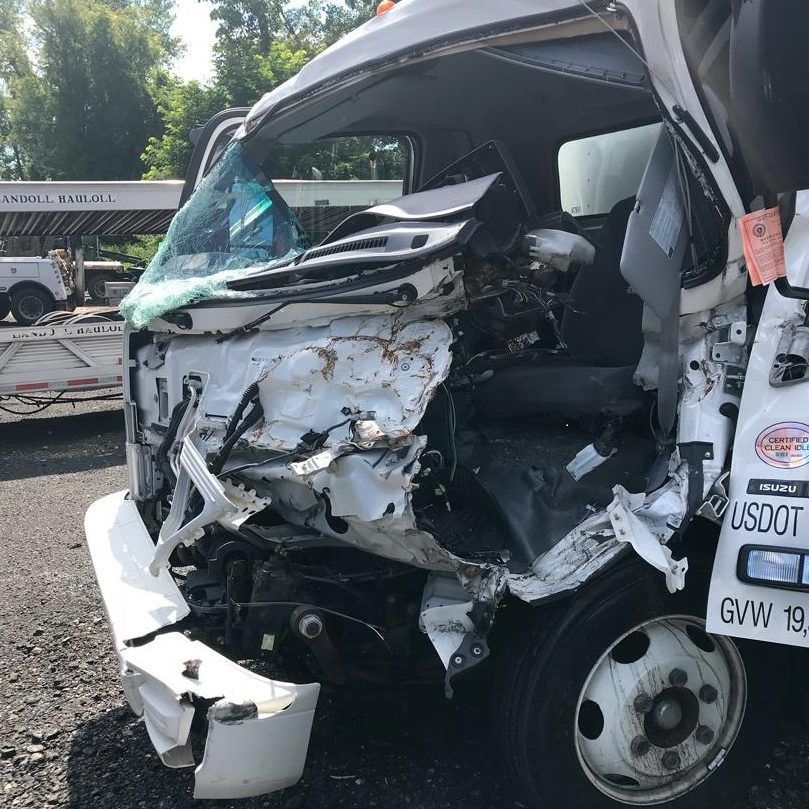Cabover Delivery Truck Safety Issues and Legal Remedies
As lawyers handling truck accidents, we often get asked questions about cabover delivery trucks or low cab forward trucks. Unless you’re a driver, you may not know these trucks by name – but you have almost certainly seen them on the road either on the highway or in town. While they do come with some advantages, they can also be very dangerous in the event of a crash. Read on to learn what a cabover engine truck is, how safe they are, and what to do if you are injured while operating a cabover or low cab forward truck.
What is a cabover truck?
Cabover trucks refer to a truck body-style or design where the cab (passenger area) is positioned directly above the engine & front axle. They are also called cab forward and, descriptively, flat face/front trucks because they do not have a hood & engine compartment in front of the driver.
Cabover trucks can be manufactured at multiple Gross Vehicle Weight Rating (GVWR) categories, from light to heavy-duty. However, heavy cabover or flat face semi-trucks are much less common in the United States than they were in the past. These days, you are much more likely to see a light- or medium-duty cab forward or cabover engine box truck making shorter trips in local or more congested areas.
Cabover Trucks vs Conventional Semi-trucks
When most people think of truck drivers, they picture them driving conventional class 8 trucks with long-nosed hoods and 18 wheels. However, commercial vehicles come in many sizes and configurations.
The size of trucks is often designated by a class that is based on the vehicle’s gross vehicle weight rating (GVWR). There are three categories of commercial trucks within the class system: light-duty trucks (classes 1, 2 and 3), medium-duty trucks (classes 4, 5 and 6) and heavy-duty trucks (classes 7 and 8).
Within those classes, there are two primary body styles for commercial trucks, conventional and cabover engine. Conventional trucks have a long nose and a traditional engine compartment, while cabover engine trucks have a flat nose and the cab sits on top of the engine and front steer axle.
Cabover engine trucks first gained popularity in the United States in the mid 1950s as heavy-duty trucks. Manufacturers such as International, Kenworth, Peterbilt and GMC pushed these trucks as a solution to newly implemented state restrictions on the overall length of the truck and trailer. The lack of a traditional engine compartment allowed the trucks to meet length restrictions without sacrificing trailer space.
What happened to cabover trucks?
By the mid-1970s the length restrictions were changed such that conventional trucks regained the lion’s share of the heavy-duty truck market. Yet, as the demand for heavy-duty cabover engine trucks waned, manufacturers like Isuzu, Hino and Mitsubishi recognized a market for light and medium-duty cabover engine trucks to be used as local and short trip delivery vehicles.
What is a low cab forward truck?
Light or medium-duty cabover trucks are sometimes also referred to as “low cab forward” trucks. The manufacturers championed the small turning radius and maneuverability of these vehicles in tight urban or loading dock situations while still being large enough to haul significant loads. As a result, light and medium-duty cabover engine trucks became very popular with companies making local deliveries and other service providers such as landscapers, plumbers and HVAC professionals. You have undoubtedly driven by hundreds of these trucks in your neighborhoods and city streets. You probably didn’t realize that they are incredibly unsafe.
Cabover Truck Manufacturers
Light & Medium-duty | Cab Forward | Cabover Box Trucks
- Isuzu
- Hino
- Mitsubishi-Fuso
- Chevrolet
- Ford
- Hyundai
- Iveco
- Mazda
- Nissan
- Renault
- Scania
- Toyota
Heavy-duty | Cabover Semi-Trucks
Heavy-duty cabover trucks are rarely built for use in the United States (although some are built here for use elsewhere). If you see a historic cabover semi-truck, or remember one from your past, it may have been manufactured by one of the following:
- International
- Kenworth
- Peterbilt
- Freightliner
- GMC
- Ford
- Diamond Reo
Cabover Engine Truck Advantages & Benefits
As outlined above, manufacturers of these vehicles tout their small turning radius and maneuverability in tight urban or loading dock situations. That coupled with the truck’s capability to haul significant loads has made light and medium duty cabover engine trucks popular in many industries. Drivers of these trucks also notice the increased visibility that comes from lacking a long hood.
These trucks are often used by local or short haul delivery companies, junk hauling companies, landscaping crews, and trade professionals such as HVAC technicians, plumbers and electricians. These trucks can even be used as moving trucks for short haul moving. Cab forward trucks are being utilized in a variety of industries, in part because they carry a smaller price tag than a larger heavy duty conventional truck, but also because they are easier to maneuver around neighborhood and city streets.
Are cabover trucks safe?
Cabover trucks are particularly unsafe in frontal collisions. By design, cabover trucks lack the “crumple zone” in the engine compartment & hood, which can result in serious injuries for cabover truck drivers & passengers.
While conventional heavy and medium-duty trucks have countless crashworthiness problems, the conventional configuration does include some front-end structure, namely the engine compartment, that functions as a “crumple zone” that helps to absorb the forces in a frontal collision. These structures are certainly not perfect, as they can be damaged and cause other consequences such as post collision fires and loss of steering control. However, the front structures between the cab and the front bumper can prevent the frontal collision damage from intruding into the occupant compartment.
The same cannot be said for cabover engine or low cab forward trucks. When cabover engine trucks are involved in frontal collisions in the U.S., the damage to the front end and occupant compartment is staggering. There is simply very little protective structure in the front end of a cabover engine truck, certainly nothing that could be called a “crumple zone.” As a result, cabover engine truck occupants frequently suffer fatal or severe crush and amputation injuries to their legs.

Common Cabover Engine Accident Injuries
Due to the minimal front structure of cabover or low cab forward trucks, operators typically suffer severe injuries to their legs. Common injuries include severe orthopedic injuries such as crush fractures to the feet, ankles, tibia, fibula and even the femur. Injuries can also include crush damage to operators’ lower legs that result in the need for amputation or can even cause severe blood loss that leads to death.
What should I do if I was hurt in a crash involving a cabover engine truck?
Cabover engine trucks may no longer be as prevalent on the highways where typical semi-truck crashes occur. Yet, local delivery drivers across the country are exposed to the significant dangers of these trucks every day. The resulting injuries could be avoided and should be prevented in part through additional safety measures by the truck manufacturers.
If you or someone you know was involved in a collision while operating a light or medium duty cabover engine truck, and suffered injuries, those injuries could be the result of a defect in the truck’s design or manufacture. You need a lawyer that can investigate the crash, determine what caused your injuries and hold the truck manufacturer accountable.
Cabover Truck Accident Attorneys
McCartney Stucky has successfully handled many cabover engine truck accident cases. We are deeply familiar with the manufacturers, safety issues and the alternative designs that could prevent the injuries suffered in cabover truck collisions. If you were injured, it’s important you contact an attorney with experience in defective heavy truck cases. Our team of lawyers is available and ready to listen to your story and help you pursue any claims that you may have as a result of injuries suffered in a cabover engine truck. Please reach out to us by phone at 816-994-4040 or 914-305-5555. You can also contact us online to schedule a consultation.

